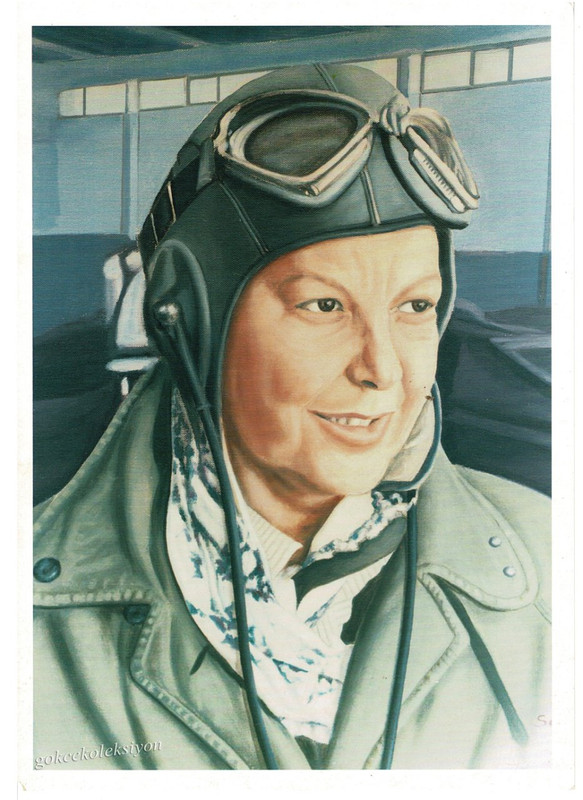1913 - 2001
Date Added:
Edited

Considered the world’s first female fighter pilot at age 23, Sabiha Gokcen was an orphan and one of the thirteen adopted children of Mustafa Kemal Ataturk. Atatürk stopped in Bursa, and newspaper accounts of the day report that a 12-year-old female approached the president and requested assistance with continuing her education at a boarding school. With this bold move Gökçen became one of several children adopted by Atatürk, including two other teenaged girls, Zehra and Rukiye, who preceded her in the household. The others included daughters Afet, Fikriye, Ülkü, Nebile, and a boy named Mustafa. Gökçen arrived in Ankara, Turkey's second largest city and its new capital under Atatürk, and began her education at the Çankara Primary School, which was attached to the presidential residence. She later went on to the Üsküdar Girls College in Istanbul, Turkey's largest city. She reportedly suffered from health problems, however, which curtailed her education. Gökçen was known simply as Sabiha until Atatürk's Surname Act of June 21, 1934, went into effect. This required all citizens to take a family name, which had not been part of Turkish society prior to that time. Atatürk had originally been known as Gazi Mustafa Kemal Pasha, with "Pasha," like the "Bey" attached to the name of Gökçen's biological father, serving as an honorific title denoting, respectively, king and chieftain. Atatürk's newly adopted surname meant "Father of All Turks," and he named Sabiha Gökçen, or "of the sky." It was a prophetic moniker, for she had not yet settled on aviation as her career. That same year, Atatürk granted Turkish women full political rights, making Turkey one of the first nations in the world to give women the right to vote. In his ongoing modernization plan, aviation ranked high among the national priorities, and in May of 1935 Atatürk presided over the official opening of the Türkkușsu Flight School. Gökçen was with him that day, and she was reportedly delighted by the skydivers and parachutists who took part in an air show as part of the day's ceremonies. When Atatürk asked her if she would like to do that, too, she reportedly replied she was ready to start training right away. Atatürk informed the director of the Türkkușsu Flight School that Gökçen was to be enrolled as its first female student. Gökçen soon realized she might be better suited to flying aircraft than to jumping out of them, and earned her pilot's license instead. Afterward she was sent to the Soviet Union for advanced training, along with seven other pilots, all of them men. She made her first solo flight in 1936, an achievement excitedly chronicled in the Turkish press as emblematic of the new freedoms available to all Turkish women. Atatürk also permitted her to begin training at Turkey's Military Aviation Academy as a military pilot, but as Mango described, Gökçen recalled in her memoirs that "Atatürk tested her by asking her to press a gun against her head and pull the trigger," and "she did not flinch." Gökçen trained on bombers and fighter planes at an air base in Eskișehir, a province in the northwest which was also home to the Military Aviation Academy. She flew in standard military flight exercises over the Aegean Sea in 1937, and also took part in her sole combat mission that same year. As Mango noted, because she had not flinched at the firearm test Atatürk allowed her to participate in the bombing of a Kurdish uprising in Dersim, a province later known as Tunceli. "She was given a gun—which was loaded this time—to defend herself if her plane crashed and she fell into rebel hands." Instead she managed to bomb the home of an insurgent leader, killing him and several associates, before returning to base safely. In 1938 Gökçen made a historic flight around the Balkans that lasted five days until her plane was sidelined by mechanical problems. This was a well-publicized peace mission, and newspapers across Europe chronicled her stops in Greece, Bulgaria, Yugoslavia, and Romania. Atatürk died later that year, on November 11, of cirrhosis of the liver. News reports from the time placed her at his bedside along with his sister and the prime minister. Subsequent news stories mentioned that she began a hunger strike out of grief, but was persuaded to abandon it. Gökçen held the post of director of training for the Türkkușsu Flight School, and the rank of lieutenant in the Turkish Air Force. In 1940 she married Kemal Esiner, an Air Force major, but he died in 1943. She retired in 1955 and officially retired from flying in 1964. Her 1981 memoir, A Life Along the Path of Atatürk , appeared as part of centenary celebrations of his birth. In early 2001 Istanbul's second international airport of Istanbul was named in her honor. Gökçen died two months after the official opening of the airport, on March 22, 2001, at the Gulhane Military Medical Academy in Ankara, and was one of the last surviving family members of Atatürk's immediate family. In the decades following her adoptive father's death, his firm commitment to the separation of church and state in Turkey was still under attack by more conservative Islamic forces in the country. "There are some unfortunates who are trying to destroy this great individual," she said a year before her death, according to Turgut, the author of her obituary in London's Independent newspaper. "I condemn these attacks. May God keep this country on the path which he drew."
Share your thoughts on this story with us. Your comments will not be made public.
Email
Copyright ©2016 - Design By Bureau Blank